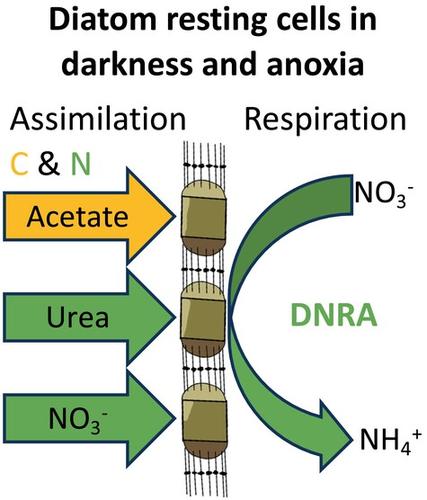当前位置:
X-MOL 学术
›
Environ. Microbiol.
›
论文详情
Our official English website, www.x-mol.net, welcomes your feedback! (Note: you will need to create a separate account there.)
Resting cells of Skeletonema marinoi assimilate organic compounds and respire by dissimilatory nitrate reduction to ammonium in dark, anoxic conditions
Environmental Microbiology ( IF 5.1 ) Pub Date : 2024-04-23 , DOI: 10.1111/1462-2920.16625 Rickard Stenow 1 , Elizabeth K. Robertson 1 , Olga Kourtchenko 1 , Martin J. Whitehouse 2 , Matthew I. M. Pinder 1 , Giovanna Benvenuto 3 , Mats Töpel 1, 4 , Anna Godhe 1 , Helle Ploug 1
Environmental Microbiology ( IF 5.1 ) Pub Date : 2024-04-23 , DOI: 10.1111/1462-2920.16625 Rickard Stenow 1 , Elizabeth K. Robertson 1 , Olga Kourtchenko 1 , Martin J. Whitehouse 2 , Matthew I. M. Pinder 1 , Giovanna Benvenuto 3 , Mats Töpel 1, 4 , Anna Godhe 1 , Helle Ploug 1
Affiliation

|
Diatoms can survive long periods in dark, anoxic sediments by forming resting spores or resting cells. These have been considered dormant until recently when resting cells of Skeletonema marinoi were shown to assimilate nitrate and ammonium from the ambient environment in dark, anoxic conditions. Here, we show that resting cells of S. marinoi can also perform dissimilatory nitrate reduction to ammonium (DNRA), in dark, anoxic conditions. Transmission electron microscope analyses showed that chloroplasts were compacted, and few large mitochondria had visible cristae within resting cells. Using secondary ion mass spectrometry and isotope ratio mass spectrometry combined with stable isotopic tracers, we measured assimilatory and dissimilatory processes carried out by resting cells of S. marinoi under dark, anoxic conditions. Nitrate was both respired by DNRA and assimilated into biomass by resting cells. Cells assimilated nitrogen from urea and carbon from acetate, both of which are sources of dissolved organic matter produced in sediments. Carbon and nitrogen assimilation rates corresponded to turnover rates of cellular carbon and nitrogen content ranging between 469 and 10,000 years. Hence, diatom resting cells can sustain their cells in dark, anoxic sediments by slowly assimilating and respiring substrates from the ambient environment.
中文翻译:

马里诺骨条藻的静息细胞在黑暗缺氧条件下同化有机化合物并通过异化硝酸盐还原为铵进行呼吸
硅藻可以通过形成休眠孢子或休眠细胞在黑暗、缺氧的沉积物中长时间生存。直到最近,当休眠细胞马里诺骨条虫 研究表明,在黑暗、缺氧的条件下,它们可以从周围环境中吸收硝酸盐和铵。在这里,我们展示了静息细胞马里诺沙门氏菌 还可以在黑暗缺氧条件下进行硝酸盐异化还原成铵 (DNRA)。透射电子显微镜分析表明,叶绿体被压实,静息细胞内很少有大线粒体具有可见的嵴。利用二次离子质谱和同位素比质谱结合稳定同位素示踪剂,我们测量了静息细胞进行的同化和异化过程。马里诺沙门氏菌 在黑暗、缺氧的条件下。硝酸盐既被 DNRA 呼吸,又被休眠细胞吸收为生物质。细胞从尿素中吸收氮,从醋酸盐中吸收碳,这两者都是沉积物中产生的溶解有机物的来源。碳和氮同化率对应于 469 至 10,000 年之间细胞碳和氮含量的周转率。因此,硅藻休眠细胞可以通过缓慢地同化和呼吸周围环境中的底物来维持其细胞在黑暗、缺氧的沉积物中的生存。
更新日期:2024-04-23
中文翻译:

马里诺骨条藻的静息细胞在黑暗缺氧条件下同化有机化合物并通过异化硝酸盐还原为铵进行呼吸
硅藻可以通过形成休眠孢子或休眠细胞在黑暗、缺氧的沉积物中长时间生存。直到最近,当休眠细胞



























 京公网安备 11010802027423号
京公网安备 11010802027423号